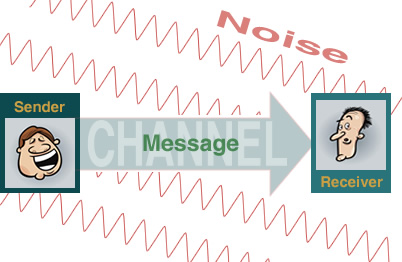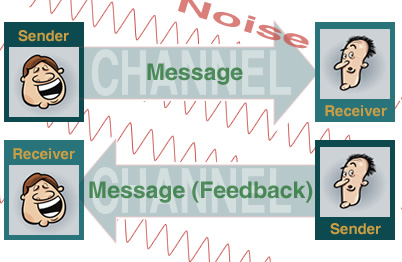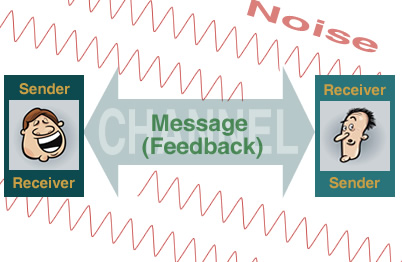Today we’re going to be discussing the Three (3) Models of Communication, but before we hop into it, you should be sure that you are up to speed with your communication terminology. You might want to have our glossary handy, or you might want to head to The Communication Process article for a quick review.
The Communication Models
The purpose of a “model” is to offer a visual representation of a concept with the intent of facilitating the understanding of it. Traditionally speaking, there are three standard models of the communication process: Linear, Interactive, and Transactional, and each offers a slightly different perspective on the communication process.
Linear Communication Model
There’s a bit of a debate about the Linear Communication model and how it recognizes (or doesn’t recognize) the concept of feedback. The linear model’s behavior is belied by its name, where a sender encodes a message via a channel and the message is decoded by the receiver. It is straight-line communication found typically in mass communication; think television, radio, newspapers, etc. According to this model, there is no means for immediate feedback.

Shannon and Weaver were the first to present the Linear Model of Communication in 1949′s The Mathematical Theory of Communication. We’re going to discuss more about these two in our imminent Theories of Communication article. Suffice to say that this theory has become less relevant in inverse proportion to the advances of communication technology, specifically non-linear forms of electronic communication where it’s not always clear who is the sender and who is the receiver.
Interactive Communication Model
Simply put, the Interactive Model takes the Linear Model and multiplies it times two with a quick flip of the return message. It now allows for a feedback element because after a message is encoded and sent to the decoding receiver, the roles then reverse and the receiver encodes and sends a response to the original sender who has now turned receiver. It sounds more confusing than it is. Envision an exchange of text messages whereby your friend sends you a message and you respond to it. The same thing happens during a telephone call, or even an email exchange. A message is sent and received, then the roles reverse. That is the Interactive Model.

Transactional Communication Model
The Transactional Model becomes more sophisticated yet. This model depicts face-to-face interaction, or “trans-action” as a dynamic and changeable process that is not limited to simple definition. In the Transactional Model, receiver and sender can play the same roles simultaneously, as sometimes happens, as messages can be sent back and forth simultaneously. It appears chaotic and ineffective, but sometimes communication is just that. Throw in some noise, and it would be a wonder whether any message is conveyed successfully in this environment.

As mentioned, we’re going to touch upon these three models of communication in a future article where we shall go further into communication theory and some of the major influencers in the field of communications over the past few decades.
As always, we encourage to to share your comments and questions. We always learn more when we learn as a group. Also, be sure to sign up for email/RSS updates (in the right sidebar) and link to our work on your favorite social media and forums. Thanks for reading! MC
—-
Get Paid to Write
Turn the writing skills you already have into a highly-paid recession-proof profession …working part time! You’re already a writer. Find out how you can earn $100 to $150 per hour from this little-known lucrative profession.










Sally Curtis
I like the “messy” face to face transactional communication as it is far harder to be misinterpreted.
Sally
I agree to an extent and that is the “noise” that can, and frequently does, complicate interpretation.
Thanks for such a good information.
Yeah have been really helped…
Thank you so much i appreciate
Interesting. What connections do you think that this has to do with nonlinear and linear communicators? Do you think each gravitate towards a certain kind of communication.
Really helpful, thanks
I really benefitted ,thank you
Thanks for the article. It is very helpful to more. But please i have a question. How can we say that sms and emails are examples of interactive mode. Because I think in this model there is immediate feedback but the sender wait for the receiver and vice versa. I think we should put something like a walkie – talkies where can’t talk at the same time. I welcome corrections please. Thanks. No insults
Thank you so much, this has been a great help to me.
Thanks so much. it was really helpful
What then is d similarities between transactional mode and linear
Thanks alot for such good information.
that was a very simple and well elaborated explanation.Thanks team
especially on the Transactional mode, it was once confusing but ts all fine now
you have simple grammar and your explaination are clearly understood how i wish you would give and explain more communication models and please send to my email written below .. thank you the website is awesome
Week one of a Managerial and Business Communication class. This cite is referenced for discussion of communication. The first part of the first sentence in the article reads “Today we’re going to be discussion” like this. Is that setting a good example for an article on communication?
Dave – thanks for pointing that out!
Are Shramm, Shanon, Aristotles mode of communication? or the above types models are the same as the ones I have mentioned?